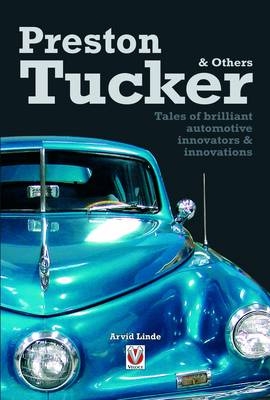
Preston Tucker & Others
Veloce (Verlag)
978-1-84584-017-4 (ISBN)
Can you imagine a world where people drive beautiful and unusual cars, created by designers prodigiously endowed with talent and imagination?
Names like Preston Tucker, Carl Borgward and John DeLorean are hardly known today. Nevertheless, today’s cars would be a lot different without their contributions to automotive engineering. Although the car is a technological and rational affair, it’s the dreamers and eccentrics like these who have made the biggest contribution to the development of the industry; those who have had the ability to think beyond their time and conventions. Money doesn’t drive progress in the car business – it is a passion for speed, and an obsession with mechanisms. Yet for many a dreamer, this passion has ended in fiasco. Misunderstood and pushed aside by their contemporaries, they have been forced to watch their dreams trampled underfoot.
This book takes a look at the history of the car from a different angle,avoiding the mainstream moguls and telling a story about a man and his dream, and the like-minded people that came before and after him. Lavishly illustrated and intensively researched, it documents the making of some of the strangest and greatest cars of the past century. The main section is devoted to the unsung heroes of motoring, and the rest of the book shines a light on the many ingenious inventions we now take for granted.
Let’s show some respect to the dreamers. Our world wouldn’t be so exciting without them.
Arvid Linde is a car enthusiast and an appreciator of eccentric design ideas. He has an MSc degree in Car Engineering and Logistics but has currently found himself on a career path of new media marketing. Arvid is Estonian. He worked as a car journalist for more than 10 years before moving to the UK. He now edits electriccarnews.co.uk website where he tries to unravel the dilemma of whether the electric car is the answer to the green motoring needs of the 21st century, or just another political gimmick The constant dissatisfaction with some of the modern car design tendencies has worked for him as an inspiration to recall the times when engineers were more passionate about cars.
Part 1 - The dreamers John DeLorean - Sweet, Fast Life A look into both the private and business life of the famous John DeLorean, following his extraordinary road from success to complete failure. Preston Tucker - Too Good for his Time The life of Indy 500 engineer Preston Tucker, and the strange fate of his helicopter-powered car, Torpedo, still regarded as one of the best cars of all times. Felix Wankel The genius German engineer, author of the only working prototype of a rotary engine, who was not recognized until after his death. Gabriel Voisin Known as the greatest design philosopher of his time. Inspired by industrial fantasists Clement Ader and Le Corbusier, his cars fulfilled an idea of ergonomics coupled with unusual shapes. Carl Borgward Building the best cars in Germany was not enough. A true story about how BMW destroyed its competitor in 1961. Malcolm Bricklin Also known as the unsinkable Bricklin. He has had more failures and scandals than anyone else in the car business, yet surprisingly he has never been in jail and still keeps generating crazy ideas. Gerald Wiegert A man whose quest was to build the first All-American supercar that would be better than Lamborghini. He fulfilled his dream by creating the Vector W8, but had to pay a price like other dreamers. Roumen Antonov The Bulgarian inventor, currently living in Paris, invented a revolutionary new type of internal combustion engine, a new gearbox, and tried to revive the Bugatti Atlantic in his 4-stroke prototype. Still operating with huge losses, he will probably come out as a winner eventually. Guy Negre He surprised the world by inventing a way to produce cheap zero-emission vehicles. His Air-car is powered by compressed air, but the start of mass-production has been postponed since 2000. The next launch date is 2011 - is it going to be yet another failure? Part 2 - Times and countries Panhard & Levassor The trailblazers of the French car industry, Panhard & Levassor are now totally forgotten, despite pioneering the front engine layout that is still used in modern day car production. The last romantics Producing exclusive and pricey cars in France of the 50s and 60s was probably a crazy idea. That's why Facel Vega, Monica and even Citroen failed. No luxury car has been mass-produced in France after 1970. The end of the royal cars The unfortunate timeline of events that led Britain from being the top car manufacturer in Europe to a country where there are no native cars produced at all. Under the red stamp A tribute to the talented car designers of Russia whose projects failed to see daylight. The story ends on a more positive note, telling about the achievements of Russian contemporary designers. Part 3 - There is nothing new about a car Internal combustion engine Popular culture has made Gottlieb Daimler the inventor of the internal combustion engine. However, the idea was first described by Al-Jazari and Leonardo da Vinci, the first working prototype was allegedly built by Huygens back in 1673, but it was an Englishman who patented the first working engine. Electric cars An electric car is not an invention of the 21st century. In fact, the concept has existed for more than 170 years. The first working example was built in 1834. Fuel cells How about the naughty announcement by General Motors in 1967 that it had invented a fuel cell powered car, suggesting it had developed the entire idea? The first fuel cell was built by William Robert Grove in 1838. Turbo boost The invaluable invention was patented by coal-miner Francis Roots in 1860. Carburettor Neither Karl Benz nor Donat Banki was the first man to build a carburettor. Siegfried Markus created a brush carburettor in 1875, and Frederick Lanchester built his wick carburettor around 1890. Disc brakes The first set of disc brakes was produced by Frederick Lanchester in 1901, yet 107 years later, there are producers that still mount drum brakes on their cars. 4x4 car Four-wheel drive was first designed by a Dutch firm, Spyker, in 1902. Just five years later the Caldwell brothers pushed the boundaries even further by creating a 4x4 car with a four-wheel steering system that allowed the car to move sideways. Windscreen wiper One of the only automotive inventions contributed by a lady. Mary Anderson patented the first windscreen wiper in 1905 and Charlotte Bridgewood improved her design in 1917. Electric horn Although pneumatic klaxons were in use up until the early '30s, the first electric horn was invented in 1908. Fuel injection system Although the modern fuel injection system was perfected by Bosch during the '50s, it was as early as 1898 that Frederick Lanchester started experimenting with injection. 1910 is the year when the first steadily working fuel injection system was built by Adam Farwell. Motor starter A simple hand crank was used to start an engine in early motor cars. It was both tough and dangerous. Charles Kettering built a working example of an electric starter in 1910 but it took almost 40 years for all carmakers around the world to stop using hand cranks. Hydraulic brakes Malcolm Lockheed invented hydraulic brakes in 1918. Although his invention was considered suspicious, it took only three years for hydraulic brakes to appear on a Duesenberg. They had no choice - the car was too fast and too heavy for anything else to be able to stop it. Short and exciting facts about car ergonomics and other inventions, like the first car stereo, first front-wheel drive car, first fuel station, electric windows and air-bags. 6 Index by model name, code, issue date
| Erscheint lt. Verlag | 15.2.2011 |
|---|---|
| Sprache | englisch |
| Maße | 152 x 225 mm |
| Gewicht | 425 g |
| Themenwelt | Kunst / Musik / Theater ► Design / Innenarchitektur / Mode |
| Natur / Technik ► Fahrzeuge / Flugzeuge / Schiffe ► Auto / Motorrad | |
| Geisteswissenschaften ► Geschichte | |
| Technik ► Fahrzeugbau / Schiffbau | |
| ISBN-10 | 1-84584-017-8 / 1845840178 |
| ISBN-13 | 978-1-84584-017-4 / 9781845840174 |
| Zustand | Neuware |
| Haben Sie eine Frage zum Produkt? |
aus dem Bereich


